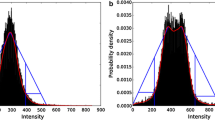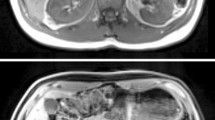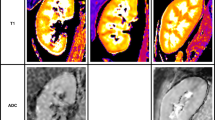Abstract
Volumetric analysis of the kidney parenchyma provides additional information for the detection and monitoring of various renal diseases. Therefore the purposes of the study were to develop and evaluate a semi-automated segmentation tool and a modified ellipsoid formula for volumetric analysis of the kidney in non-contrast T2-weighted magnetic resonance (MR)-images. Three readers performed semi-automated segmentation of the total kidney volume (TKV) in axial, non-contrast-enhanced T2-weighted MR-images of 24 healthy volunteers (48 kidneys) twice. A semi-automated threshold-based segmentation tool was developed to segment the kidney parenchyma. Furthermore, the three readers measured renal dimensions (length, width, depth) and applied different formulas to calculate the TKV. Manual segmentation served as a reference volume. Volumes of the different methods were compared and time required was recorded. There was no significant difference between the semi-automatically and manually segmented TKV (p = 0.31). The difference in mean volumes was 0.3 ml (95% confidence interval (CI), −10.1 to 10.7 ml). Semi-automated segmentation was significantly faster than manual segmentation, with a mean difference = 188 s (220 vs. 408 s); p < 0.05. Volumes did not differ significantly comparing the results of different readers. Calculation of TKV with a modified ellipsoid formula (ellipsoid volume × 0.85) did not differ significantly from the reference volume; however, the mean error was three times higher (difference of mean volumes −0.1 ml; CI −31.1 to 30.9 ml; p = 0.95). Applying the modified ellipsoid formula was the fastest way to get an estimation of the renal volume (41 s). Semi-automated segmentation and volumetric analysis of the kidney in native T2-weighted MR data delivers accurate and reproducible results and was significantly faster than manual segmentation. Applying a modified ellipsoid formula quickly provides an accurate kidney volume.






Similar content being viewed by others
References
Abraham G, et al.: Chronic kidney disease hotspots in developing countries in South Asia. Clinical kidney journal 9:135–141, 2016
Grams ME, et al.: Trends in the prevalence of reduced GFR in the United States: a comparison of creatinine- and cystatin C-based estimates. American journal of kidney diseases : the official journal of the National Kidney Foundation 62:253–260, 2013
Coresh J, et al.: Prevalence of chronic kidney disease in the United States. Jama 298:2038–2047, 2007
White SL, Polkinghorne KR, Atkins RC, Chadban SJ: Comparison of the prevalence and mortality risk of CKD in Australia using the CKD Epidemiology Collaboration (CKD-EPI) and Modification of Diet in Renal Disease (MDRD) Study GFR estimating equations: the AusDiab (Australian Diabetes, Obesity and Lifestyle) Study. American journal of kidney diseases : the official journal of the National Kidney Foundation 55:660–670, 2010
Matsushita K, Tonelli M, Lloyd A, Levey AS, Coresh J, Hemmelgarn BR: Clinical risk implications of the CKD Epidemiology Collaboration (CKD-EPI) equation compared with the Modification of Diet in Renal Disease (MDRD) Study equation for estimated GFR. American journal of kidney diseases : the official journal of the National Kidney Foundation 60:241–249, 2012
Keller G, Zimmer G, Mall G, Ritz E, Amann K: Nephron number in patients with primary hypertension. The New England journal of medicine 348:101–108, 2003
Ritz E, Amann K, Koleganova N, Benz K: Prenatal programming-effects on blood pressure and renal function. Nature reviews Nephrology 7:137–144, 2011
Jones RA, Easley K, Little SB, Scherz H, Kirsch AJ, Grattan-Smith JD: Dynamic contrast-enhanced MR urography in the evaluation of pediatric hydronephrosis: Part 1, functional assessment. AJR American journal of roentgenology 185:1598–1607, 2005
Bakker J, Olree M, Kaatee R, de Lange EE, Beek FJ: In vitro measurement of kidney size: comparison of ultrasonography and MRI. Ultrasound in medicine & biology 24:683–688, 1998
Bakker J, et al.: Renal volume measurements: accuracy and repeatability of US compared with that of MR imaging. Radiology 211:623–628, 1999
Li S, et al.: Wavelet-based segmentation of renal compartments in DCE-MRI of human kidney: initial results in patients and healthy volunteers. Computerized medical imaging and graphics : the official journal of the Computerized Medical Imaging Society 36:108–118, 2012
Grenier N, Basseau F, Ries M, Tyndal B, Jones R, Moonen C: Functional MRI of the kidney. Abdominal imaging 28:164–175, 2003
Coulam CH, Bouley DM, Sommer FG: Measurement of renal volumes with contrast-enhanced MRI. Journal of magnetic resonance imaging : JMRI 15:174–179, 2002
de Bazelaire CM, Duhamel GD, Rofsky NM, Alsop DC: MR imaging relaxation times of abdominal and pelvic tissues measured in vivo at 3.0 T: preliminary results. Radiology 230:652–659, 2004
Di Leo G, Di Terlizzi F, Flor N, Morganti A, Sardanelli F: Measurement of renal volume using respiratory-gated MRI in subjects without known kidney disease: intraobserver, interobserver, and interstudy reproducibility. European journal of radiology 80:e212–216, 2011
Kanki A, et al.: Corticomedullary differentiation of the kidney: evaluation with noncontrast-enhanced steady-state free precession (SSFP) MRI with time-spatial labeling inversion pulse (time-SLIP). Journal of magnetic resonance imaging : JMRI 37:1178–1181, 2013
Cohen BA, Barash I, Kim DC, Sanger MD, Babb JS, Chandarana H: Intraobserver and interobserver variability of renal volume measurements in polycystic kidney disease using a semiautomated MR segmentation algorithm. AJR American journal of roentgenology 199:387–393, 2012
Tang Y, Jackson HA, Filippo RED, Nelson MD, Jr, Moats RA: Automatic renal segmentation applied in pediatric MR Urography. IJIIP 1:12–19, 2010
Borgelt C, Timm H, Kruse R: Using fuzzy clustering to improve naive Bayes classifiers and probabilistic networks. Proc. Fuzzy Systems, 2000 FUZZ IEEE 2000 The Ninth IEEE International Conference on: City, 7-10 May 2000
Sun Y, et al.: Improving spatiotemporal resolution of USPIO-enhanced dynamic imaging of rat kidneys. Magnetic resonance imaging 21:593–598, 2003
Vivier PH, Dolores M, Gardin I, Zhang P, Petitjean C, Dacher JN: In vitro assessment of a 3D segmentation algorithm based on the belief functions theory in calculating renal volumes by MRI. AJR American journal of roentgenology 191:W127–134, 2008
Karstoft K, Lodrup AB, Dissing TH, Sorensen TS, Nyengaard JR, Pedersen M: Different strategies for MRI measurements of renal cortical volume. Journal of magnetic resonance imaging : JMRI 26:1564–1571, 2007
Cheong B, Muthupillai R, Rubin MF, Flamm SD: Normal values for renal length and volume as measured by magnetic resonance imaging. Clinical journal of the American Society of Nephrology : CJASN 2:38–45, 2007
Gloger O, Tonies KD, Liebscher V, Kugelmann B, Laqua R, Volzke H: Prior shape level set segmentation on multistep generated probability maps of MR datasets for fully automatic kidney parenchyma volumetry. IEEE transactions on medical imaging 31:312–325, 2012
Will S, Martirosian P, Wurslin C, Schick F: Automated segmentation and volumetric analysis of renal cortex, medulla, and pelvis based on non-contrast-enhanced T1- and T2-weighted MR images. Magma (New York, NY) 27:445–454, 2014
Gonzalez Ballester MA, Zisserman AP, Brady M: Estimation of the partial volume effect in MRI. Medical image analysis 6:389–405, 2002
Pham D, Kron T, Foroudi F, Schneider M, Siva S: A review of kidney motion under free, deep and forced-shallow breathing conditions: implications for stereotactic ablative body radiotherapy treatment. Technology in cancer research & treatment 13:315–323, 2014
Gadeberg P, Gundersen HJ, Tagehoj F: How accurate are measurements on MRI? A study on multiple sclerosis using reliable 3D stereological methods. Journal of magnetic resonance imaging : JMRI 10:72–79, 1999
Acknowledgements
The authors thank the participants of this study.
Author information
Authors and Affiliations
Corresponding author
Ethics declarations
The institutional review board of the University Hospital Erlangen/Germany approved the study. All procedures performed in studies involving human participants were in accordance with the ethical standards of the institutional and/or national research committee and with the 1964 Helsinki Declaration and its later amendments or comparable ethical standards. Informed consent was obtained from all individual participants included in the study.
Funding
This research has been supported by the Smart Data Program in the KDI project of the Federal Ministry for Economic Affairs and Energy, Germany (01MT14001E).
Conflict of Interest
The authors declare that they have no conflict of interest.
Rights and permissions
About this article
Cite this article
Seuss, H., Janka, R., Prümmer, M. et al. Development and Evaluation of a Semi-automated Segmentation Tool and a Modified Ellipsoid Formula for Volumetric Analysis of the Kidney in Non-contrast T2-Weighted MR Images. J Digit Imaging 30, 244–254 (2017). https://doi.org/10.1007/s10278-016-9936-3
Published:
Issue Date:
DOI: https://doi.org/10.1007/s10278-016-9936-3




